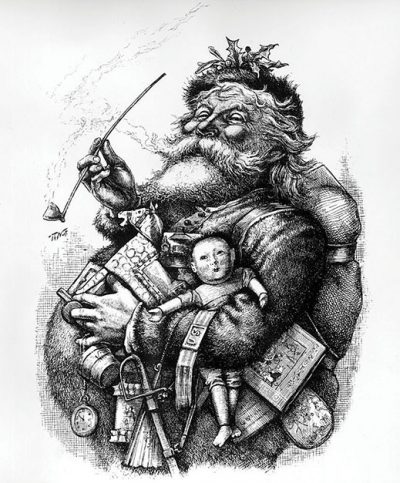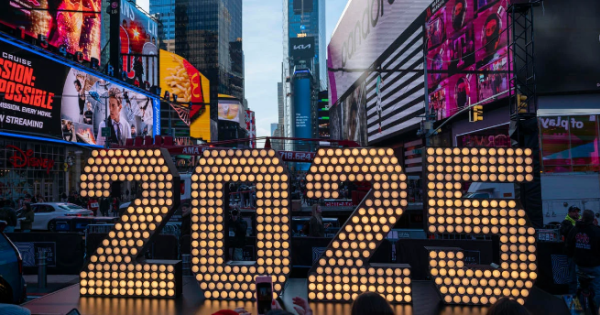From Pious Saint to Jolly Old Elf, He’s Always Giving
How Saint Nicholas of Myra evolved into Santa Claus

Old Saint Nick is a big part of the religious and commercial elements of Christmas. Let’s take a look at how a Greek saint became an oversized elf in the North Pole who delivers presents to the public.
Santa Claus, in modern American depictions, is presented to be a jolly old man who has a fondness for sweets and holding good and bad children accountable. The man benevolently tresspasses into people’s houses on Christmas and either delivers gifts for the good kids or coal for the bad kids. He usually bears a red wool suit with white fluffy lining, a red and white stocking cap, and black boots. When we were younger, many of us awaited good tidings of his arrival. His modern appearance came about in the early 20th century but his origins were mostly from the bishop, Saint Nicholas of Myra. [1]
Historically, very little is known about the saint. Accounts of Nicholas’s life come from centuries after his death with many legendary takes on who he was. According to the website Catholic Online, “Both of his parents tragically died during an epidemic when he was a young man, leaving him well off, but to be raised by his uncle – the Bishop of Patara. Nicholas was determined to devote his inheritance to works of charity, and his uncle mentored him as a reader and later ordained him as a presbyter.” He is the patron saint of sailors, merchants, archers, children, repenting thieves, pawnbrokers, brewers, and unmarried individuals. He is said to have been a secret gift giver and the bishop of the ancient Greek city, Myra. [2] One account of his generosity is when he saved three young girls from prostitution by delivering gold to them.
During the Middle Ages, children were given gifts in his honor often on the evening of his name day of December 6th. Martin Luther, the principal figure of the Protestant Reformation, popularized the tradition of giving gifts to children on Christmas in order to focus the interest of children to Jesus. [3] Regardless of the change, Nicholas remained the popular gift giver among the people.
The popular distributor of gifts on Christmas around Europe past the Middle Ages was usually a derivative of Saint Nicholas, Baby Jesus, or a folkloric character. The modern day Santa Claus shares origins not only from Saint Nicholas but also the English character, Father Christmas. He came about during the reign of King Henry VIII in the 16th century. England no longer kept the feast day of Nicholas on December 6th and so the celebration of Father Christmas was moved to December 25. He was described as an emblem of good cheer with varying depictions. [4]
Modern representations of the character merged Saint Nicholas with Father Christmas. The name of Santa Claus arises from Sinter Klaas, which is Dutch for Saint Nicholas in its shortened form.
Santa’s legend carried over to the United States with British and Dutch versions of the character merging together. The Anglicized “Santa Claus” was first used in print in 1773, predating the American Revolution. He was initially shown wearing bishop robes but the character lost them and became a parody of the New York Dutch. Washington Irving, author of Sleepy Hollow, was most responsible for this depiction and showed Santa as a thick-bellied Dutch sailor that smoked a pipe and wore a green winter coat. Irving’s version of the character was part of a broad movement in order to discourage outlandish Christmas traditions such as home invasions, pre-marital sex, and public displays of hedonism. [5] These celebrations were frowned upon by upper-class merchants and Christian purists.
Santa was first shown riding a sleigh pulled by reindeer in 1821 in the book, A New-Year’s Present, to the Little Ones from Five to Twelve. [6] An anonymously written poem in the book called Old Santeclaus with Much Delight showed Santa with a green sleigh donning a dollar sign and the word “REWARDS” in capital letters. Taken from the poem, the first stanza reads “Old SANTECLAUS with much delight. His reindeer drives this frosty night, o’r chimney tops, and tracts of snow, to bring his yearly gifts to you.” Along with his first characterization with sleigh and a reindeer, it is also the first time he was shown to come on Christmas Eve.
Some modern ideas of Santa Claus seemingly became canon after the anonymous publication of the poem A Visit From St. Nicholas (better known today as The Night Before Christmas) in the Troy, New York, Sentinel on 23 December 1823; Clement Clarke Moore later claimed authorship, though some scholars argue that Henry Livingston, Jr. (who passed away nine years before Moore’s claim) was the author. St. Nick is described as being “chubby and plump, a right jolly old elf” with more reindeer being added and named: Dasher, Dancer, Prancer, Vixen, Comet, Cupid, Dunder and Blixem (later Donner and Blitzen). The idea of Rudolph the Red-Nosed Reindeer came about almost 100 years later in 1939. [7]
Santa Claus grew bigger and heavier as the years went by. Santa Claus was immortalized by Thomas Nast, an American cartoonist of the 19th century. [8] Nast was one of the first artists to define Santa Claus’s modern image. In an 1881 illustration by Nast, he was shown as a jolly old man with a fluffy white beard, warm winter clothing, a handful of toys, and a smile going from ear to ear. [9]
Nast might possibly be responsible for the myth that Santa Claus resides at the North Pole. His holiday illustration appeared in Harper’s on December 29, 1866. It was a collage of engravings titled Santa Claus and His Works, with the caption “Santa Claussville, N.P.” Santa Claus’s residence was described as being “near the North Pole, in the ice and snow” in a poem by George P. Webster that was included in a color collection of Nast’s illustrations released in 1869 under the same title. By the 1870s, everyone was familiar with the story. In a letter published in the children’s journal The Nursery in late 1874, a six-year old boy named Ralph Armstrong from Colorado stated: “If we did not live so very far from the North Pole, I should ask Santa Claus to bring me a donkey.”
The idea for a wife of Santa Claus most likely came about in the mid 19th century among American authors. In 1889, the poet Katharine Lee Bates popularized the character, Mrs. Claus in her poem titled “Goody Santa Claus on a Sleigh Ride” with Mrs. Claus being the narrator of the poem.
Artist Haddon Sundblom’s portrayal of Santa Claus for The Coca-Cola Company’s holiday advertisements in the 1930s helped to convey images of him. The image sparked urban legends that Santa Claus was developed by The Coca-Cola Company or that Santa wears red and white because these are the colors used to market the Coca-Cola brand. Pepsi-Cola, Coca-rival, Cola’s employed images of Santa Claus that were comparable in their advertising from the 1940s and 1950s. White Rock Beverages had previously used a red and white Santa to market mineral water in 1915 and then in advertisements for its ginger ale in 1923. Coca-Cola was not the first soft drink manufacturer in history to make use of this contemporary representation of Santa Claus in its advertising.
After these depictions came about, Santa Claus has been shown to have the same general appearance with little variation. Plump, bearded, elderly, immortal, and cheerful, Santa cemented himself as the legendary Christmas figure many Triton students know and love to this day.
If it weren’t for Saint Nicholas we wouldn’t have a Santa Claus. Through evolution in artistic impression, the saint was merged with other holiday characters. He is fundamentally different to his precursors but there’s no doubt that it’s clear to see his origins through this article.
- “Santa Claus: History, Legend, & Facts”. Encyclopedia Britannica. Retrieved 10 August 2020.
- “St. Nicholas.” Catholic Online, www.catholic.org/saints/saint.php?saint_id=371.
- Henry, Martin. “Would Christmas Be Christmas without Martin Luther?” St. Nicholas Center, 31 Dec. 2020, www.stnicholascenter.org/who-is-st-nicholas/origin-of-santa/reformation-st-nicholas/christmas-martin-luther.
- Moriarty, Tom. “The History of Father Christmas.” English Heritage, www.english-heritage.org.uk/christmas/the-history-of-father-christmas/.
- Jacqueline Simpson, Steve Roud (2000) “English Folklore”. Oxford University Press, 2000
- Fox, Justin (13 December 2019). “Christmas Was Invented in New York: The strange but probably true tale of how Washington Irving and a few contemporaries created the modern holiday in the early 1800s”. Bloomberg. Retrieved 24 December 2019.
- “The History of Rudolph the Red-Nosed Reindeer.” Altogether Christmas, www.altogetherchristmas.com/traditions/rudolph.html.
- “mentioning Don Foster, Author Unknown: On the Trail of Anonymous (New York: Henry Holt, 2000: 221–75) for the attribution of Old Santeclaus to Clement Clarke Moore”. Tspace.library.utoronto.ca. Archived from the original on 18 July 2011. Retrieved 21 December 2010.
- William J. Federer (2002). “There Really Is a Santa Claus: The History of St. Nicholas & Christmas Holiday Traditions” p. 39. Amerisearch, Inc., 2002
- Jeremy Seal, Nicholas: The Epic Journey From Saint to Santa Claus, Bloomsbury, 2005, p. 199–200. ISBN 978-1-58234-419-5.
- B. K. Swartz, Jr.; THE ORIGIN OF AMERICAN CHRISTMAS MYTH AND CUSTOMS Archived 30 April 2011 at the Wayback Machine; Retrieved 22 December 2007
- “Santa Claus: History, Legend, & Facts”. Encyclopedia Britannica. Retrieved 10 August 2020.
- Fox, Justin (13 December 2019). “Christmas Was Invented in New York: The strange but probably true tale of how Washington Irving and a few contemporaries created the modern holiday in the early 1800s”. Bloomberg. Retrieved 24 December 2019.
- Ralph Armstrong, age 6, “A Letter From Colorado”, The Nursery, 1875, vol. 18, pp. 42–43.
- “Did White Rock or The Coca-Cola Company create the modern Santa Claus Advertisement?”. whiterocking.org. The White Rock Collectors Association. 2001. Archived from the original on 21 January 2007. Retrieved 19 January 2007.






